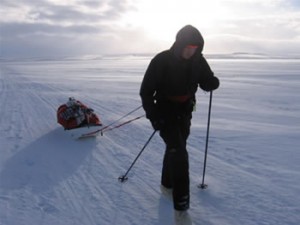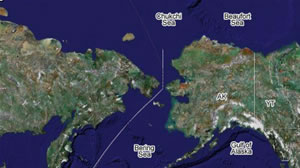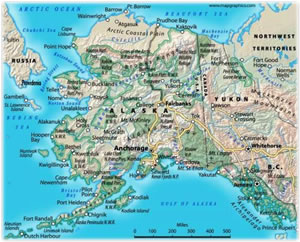Crossing the Bering Strait
It is easy when looking at a globe of the earth, to become captivated by the narrow gap separating North America and Siberia. At its narrowest point the Bering Strait is only 85 km across beckoning explorers to try crossing its icy waters.
Despite the fact that a ferry could potentially cross from the USA to Siberia in two hours, political hurdles restrict traffic across this body of water. It is virtually impossible for a westerner to receive permission to arrive on the Russian shores of the Bering Strait. An adventurer wishing to kayak, swim, walk over the ice, or sail from Alaska to Siberia across the Bering Strait would have to do so illegally.
To learn more about crossing the Bering Strait and Beringian gap, download a copy of Colin Angus’ bestselling book, Beyond the Horizon. This book details the team’s human-powered journey across Alaska, the Bering Strait and Siberia.
Methods of Transportation
Is it possible to walk across the Bering Strait?
 |
| Karl Bushby and Dimitri Kieffer crossing the Bering Strait by foot. |
A common misconception is that the Bering Strait freezes in the winter time and it is easy to walk across the ice. In reality there is a strong current flowing north through the strait which usually creates large channels of open water. On occasion these open channels become clogged with moving chunks of pan ice, so it is theoretically possible to jump from chunk to chunk, along with some swimming across the open leads. Luck is also required in having favourable currents.
There are two reported cases of successful ice crossings. The first was in 1998 when a Russian father and his son attempted walking to Alaska. They became marooned on the pack ice and spent many days drifting and cut off from shore. The ice finally reached the far side of the Strait. The men, on the brink of death staggered onto American soil. More recently in 2006 English trekker, Karl Bushby, and his American companion Dimitri Kieffer succeeded in doing the reverse route. The duo were immediately detained by the Federal Security Service and deported for entering the country illegally.
There have been several other attempts that have ended with helicopter rescues on the ice.
How about crossing in a small boat in summer?
 |
| Colin Angus and Tim Harvey in the boat they used to row across the Bering Sea |
The Bering Sea is one of the most dangerous bodies of water in the world. There are three main reasons for this; shallow depth, volatile weather, and extremely cold sea temperatures. The depths average 35 fathoms (about 200’) which means the waves are shorter and pack more power than deep sea waves. Additionally, strong currents make for difficult navigation.
It is recommended to cross in a seaworthy vessel capable of handling intense storms. It is possible to cross the narrowest part of the Bering Strait in a smaller boat such as a kayak during a calm period of weather, however a support boat would be recommended. The problem, however, is the possibility of having the boats confiscated upon reaching shore.
Bering Strait Geography
 |
| Map of Bering Strait and surrounding areas |
Little Diomede and Big Diomede Islands
These two islands are situated in the middle of the Bering Strait 3 km apart. The Russian/American border (also the International Date Line) runs between them. The smaller of these granite islands is American.
These islands can be used as a resting point during a crossing of the Bering Strait, however, being in the proximity of Russia’s Big Diomede Island will reduce the chance of a successful crossing from Alaska to Russia. It is unlikely permission will be obtained from the Russian government to cross the Bering Strait, which means a successful crossing involves keeping a low profile. There is a heavy military presence on Big Diomede and the soldiers will turn back any explorers trying to sneak into their country. From what we’ve heard they are pretty good natured, and are unlikely to shoot.
After reaching mainland Russia eventually the inevitable will happen (unless you turn around and go back) and you will be arrested and deported.
Permissions
Note: For updated (2016) information on crossing the Bering Strait, and receiving permits for arriving in Chukotka, Russia, please visit our Keynote Speakers Canada page. Information on the Bering Strait and Chukotka permits is at the bottom of the page.
How do you cross the Bering Strait legally?
This is very difficult. Not only is it necessary to arrive in Russia in an official port of call, but it is also necessary to depart from an official port of call. We have not heard of any adventurers who have received permission to arrive or depart from the remote shoreline of Russia.
Is it possible to cross from Alaska to Russia legally?
Yes, but not via the Bering Strait. It is possible to depart from Alaska outside of a port of call (a community that has customs and immigration processing facilities), but you must arrive in an official port in Russia. The closest official port to the Bering Strait in Russia’s Far East is Providenia. The distance across the Bering Sea from Alaska to Providenia is 400 km. This stretch is broken by St. Lawrence Island (American) which lies 200 km out from Alaska. The island is 125 km long, and it is 75 km from Russia.
A crossing via this route would necessitate the ability to navigate 200 km of open stormy water. It is also necessary to receive permission from the Russian government to arrive in Providenia in a small boat (a process which takes about a year).
What it is the advantage of adhering to protocol?
If your objective is nothing other than to cross from Alaska to Russia, it is probably easiest to do so by crossing the Bering Strait and dealing with the consequences (although this is not advisable or recommended). If your expedition involves more than just crossing to Russia (such as a human powered journey from Alabama to Kazakhstan) it is necessary to play by the rules so you will be granted permission to keep traveling through Russia. It is impossible to travel through Russia’s Far East without appropriate permits.
What is required to arrive and travel through Eastern Siberia?
Chukotka, Russia’s most NE state, is the last closed part of the country. This means that many of the barriers that were in place during Soviet times still apply and free travel is not allowed. This does not mean that foreigners are banned, but strict protocol must be followed.
If one were to arrive in Providenia in a small vessel such as a rowboat or sailing vessel several things are required:
Russian Visa: This is fairly easy to acquire and the procedure is outlined on the Website of most Russian consulates. You can get a Russian visa for up to a year.
Rasporyazheniye: The only thing harder than pronouncing the name of this permit is actually receiving it. Visitors to the closed state of Chukotka need an additional permit that is not required in the rest of Russia. In order to receive a rasporyazheniye you need a Chukotkan resident to sponsor you and vouch to look after you for the duration of your stay. This sponsor also needs to be registered with a special division of the government, which most people aren’t. Those who have this special registration are mainly the owners of the few “tourist” agencies so it is necessary to go through them. These agencies can be found on the official Chukotka website at: www.chukotka.org. We would not recommend Nikolai Ettynne of the organization Alliot.
Additionally, because free travel is not allowed, a detailed itinerary and outline of your route must be submitted. Each administrator or mayor of the various communities en route must give advance permission for you to enter their community. The itinerary also must be okayed by the military. It is very difficult to change your route once in the country, so plan carefully. After these requirements have been met a rasporyazheniye will be granted. It is virtually impossible for an outsider to take care of these requirements so a Chukotkan “tourist” agency must be recruited and compensated to look after these details.
Start the process of applying for your rasporyazhniye a year before you plan to arrive in Chukotka.
Special Permits: Any communications devices (including cell phones) and electronics that communicate with satellites (such as a GPS) need special permits from Moscow. If the official documents from Moscow are not procured upon arrival, these items will be confiscated. Again, the tourist agency you are working with can take care of these details, but be sure to start the process very early.
Coast Guard: If you are arriving in a small boat approval is also required from the Russian Coast Guard.
Communication: After you have received all your permissions and permits, it is essential to continually update the authorities with your ETA. It is absolutely essential not to arrive unannounced. Progress updates need to be relayed via your sponsoring organization. When you arrive in the Port of Providenia you will be greeted by about fifteen officials including customs, immigration and members of the military.
And that’s it. If you have your Russian Visa, rasporyazheniye, local sponsor, special permits, permissions and you continually communicate with the officials you will hopefully be able to step off your kayak and into the country.
We have only heard of one other expedition (apart from our own) that has entered Providenya by small boat. Mike Horn arrived from Alaska in a sailboat with two others. They had Russian visas but not their additional permits. Mike Horn was detained and deported, and his crew was sent back out to sea.
Beringian Gap Geography
 |
| Map of North American side of Beringian Gap and surrounding areas. |
What is the Beringian Gap?
There is a 5000 km gap between the Russian and American road systems. The Bering Sea is only one of the inconveniences separating the two road networks. It is an endless wilderness of boggy tundra, boreal forests and rivers. Additionally Far Eastern Russia is the coldest area on the planet outside of Antarctica.
For expeditions wishing to cross the Beringian gap by human power various factors must be considered carefully to minimize the dangers. It is virtually impossible to trek through the wilderness of Chukotka in the summer (apart from the drier peninsula stretching 750 km betweem Providenya and Anadyr) due to endless bogs, rivers, and lakes. The only realistic time to pass through this region is during the frigid winter months when all water becomes solid. Depending on what route you choose from Providenia it is between 2500 km to 3500 km to reach the roads connecting the rest of Russia.
In Alaska, the Dalton Highway joining Fairbanks to Prudhoe Bay is the last strip catering to the automobile. The easiest way to reach the Bering Sea from the Dalton Highway is to paddle down the Yukon River. It is about 1600 km from the Dalton Highway Bridge to the mouth of the Yukon.
The mouth of the Yukon River is situated at the closest point to St. Lawrence Island for the crossing to Siberia.
Bering Sea Conditions
Strong north-flowing currents sweep the upper portions of the Bering Sea. In the vicinity of St. Lawrence Island currents average half to one knot. In the Straits around Little Diomede and Big Diomede currents flow 1-2 knots.
Wind direction is extremely variable and during the summer there are no reliable prevailing winds. Visibility is often limited with thick cloud cover and light mist or fog. Storms are powerful, frequent and move in quickly. The unpredictability of the weather makes it difficult to gauge ideal weather conditions for a crossing.
Climate in Chukotka
Summer in Chukotka can be pleasant with temperatures reaching the low twenties. Often storms rolling off the Bering Sea can produce very windy conditions.
Winter in Chukotka is the most extreme in the planet. It is much, much colder than Alaska due to the fact that the prevailing weather comes from the west and chills as it moves across the largest landmass in the world. In central Chukotka temperatures hover around -50 for long periods through the winter.
It is the winds accompanying these extreme temperatures that really make the weather abysmal. The location of Chukotka between the Arctic Ocean and the Pacific creates unique meteorological conditions, and frequently winds from 50-100 km/hr blast across the peninsula. Wind chill temperature is often below -100. The lack of vegetation trees and blowing snow means that whiteout conditions are very frequent.
